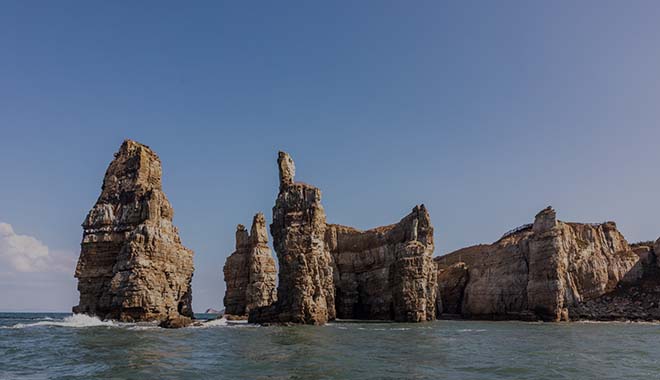Baengnyeongdo Island
Unique Rock Formation Geotrail (Section 5, 18.2 km)

Mantle Section (3.1 km, 1 hour)
- Geology + Ecology
• Exploration Highlights
: In the Baengnyeong Island geology and ecology
course, there is a predominant
focus on the
Baengnyeong Group, its basalt formation, the Earth's
crust surface,
mantle xenoliths like those in volcanic
rocks, and the spotted seal habitat.
: Kkeutseom Tombolo - Pine Trail - Hanui Beach -
Jinchon-ri Basalt - Hanui Beach
(Seal Watching) -
Ceasefire Line Trail - Last Stop: Baengnyeong-ro
316beon-gil

Natural Airfield Section (3.3 km / 2 hours)
- Geology + Terrain + History
• Exploration Highlights This course will cover the geology,
topography, and
history of a secluded beach walkway on an old airstrip.
: Changbawi Rock - Sagot Beach - Yonggipo Monument
of Unification -
Deungdae Beach - Yonggipo Sea Cave
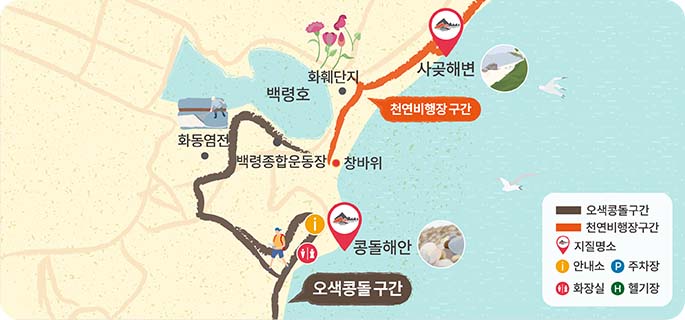
Osaek Kongdol Section (7.3 km / 2 hours)
- Geology + Terrain + Culture
• Exploration Highlights: The geology and culture courses will help students
walk
on the Hwadong Salt Pond and Baengnyeongho,
which have been critical places
for the existence of th
e people on Baengnyeongdo Island and observe various
rocks and Yeonbongbawi Rock shaping Baengnyeongdo.
: Kongdol Pebble Beach - Paddy Path -
Hwadong Salt Pond - Baengnyeongho

Yongteurim Section (3 km / 2 hrs)
- Geology + Terrain + Ecology
• Exploration Highlights: In this course, the geology, terrain, and ecology are
elaborated upon to allow participants to see how so
many of the tectonic movements (fold/fault structures)
cause shapes on Baengnyeongdo Island and to visit
the migratory bird breeding grounds that these tectonic
activities have resulted in
: Seulpeni - Nampo-ri Beach - Breeding Ground for
Rare Migratory Birds - Fold Structure in Nampo-ri -
Yongteurimbawi Rock Observatory

Dumujin Section (1.5 km / 1 hr)
- Geology + Terrain + History
• Exploration Highlights: This course covers geology, landforms, and history,
showcasing the sedimentary
and weathering
processes that sculpted what is Baengnyeong Island's
most
spectacular scenery.
: Dumujin Parking Lot - Dumujin Street of Raw Fish -
Dumujin Memorial Stone -
Unification Monument -
Dumujin Sea Cave (opens 3 hours before and after
low tide)
- Dumujin Ripple Mark (visible 3 hours
before and after low tide) - Dumujin Observatory
Daecheongdo Island
Daecheong Geotrail
(Section 5, 10.9 km)
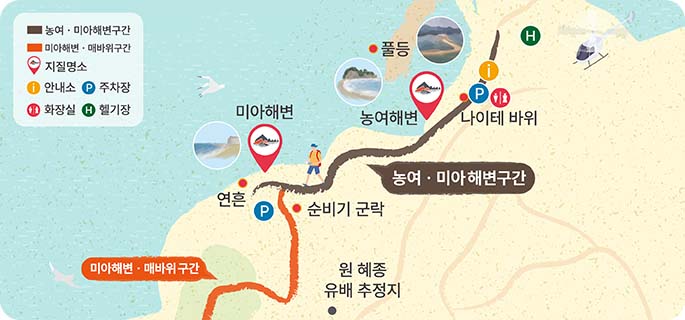
Nongyeo-Mia Beach Section
(1.2 km / 1 hour)
- Geology + Terrain + Ecology
• Exploration Highlights: This course covers geology, landforms, and ecology.
Participants can walk
along vast sandy beaches and
grasslands to observe sand deposition and
migratory
birds feeding.
: Nongyeo Beach Information - Naitebawi Rock -
Puldeung (Sand bar) -
Mia Beach - Yeonheunbawi Rock

Mia Beach-Maebawi Rock Section
(2.1km / 1.5hour)
- Geology + Ecology
• Exploration Highlights: This course features a forest trail from the back
mountains of Mia Beach
to the Maebawi Rock
Observatory
: Yeonheunbawi Rock - Daecheong Middle and High
School - Forest Trail -
Love Bridge - Maebawi Rock
Observatory

Samkaksan Mountain Section
(3.3 km / 2 hours)
- Geology + Culture + History
• Exploration Highlights: This course covers geology, culture, and history,
taking you from
Maebawi Rock Observatory to
the top of Samkaksan Mountain.
: Maebawi Rock Observatory - Top of Samkaksan
Mountain -
Gwangnandu Jeongjagak Pavilion
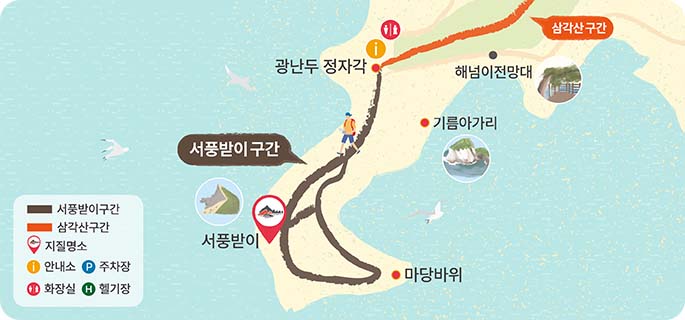
Seopungbaji Cliff Section (2.6 km / 2 hours)
- Geology + Ecology + History
• Exploration Highlights: This course on Daecheongdo Island covers geology,
ecology, and history,
featuring the towering cliffs of
Jogakbawi Rock and the expansive Madangbawi Rock.
: Gwangnandu Jeongjagak Pavilion - Sky Observatory
(Gapjukdo View) -
Seopungbaji Cliff - Cheonji Photo
Spot - Madangbawi Rock -
Galdaewon-Gwangnandu
Jeongjagak Pavilion

Sand Desert Section (1.7km / 2 hours)
- Geology + Terrain + Ecology + History
+ Culture
• Exploration Highlights: Embark on a comprehensive journey through geology,
terrain, ecology,
history, and culture. Discover the
Okjuk-dong Coastal Dune, cherished by
Okjuk-dong
residents, and explore historical sites like Daecheong
Elementary
School, formerly the location of Togon-
temür's exile palace in Nae-dong.
: Okjuk-dong Village - Okjuk-dong Coastal Dune -
Pine Trail -
Red Pine Forest Reserve - East Nae-dong -
West Nae-dong -
Daecheong Elementary School
Socheongdo Island
Geotrail (Section 2, 4.9km)
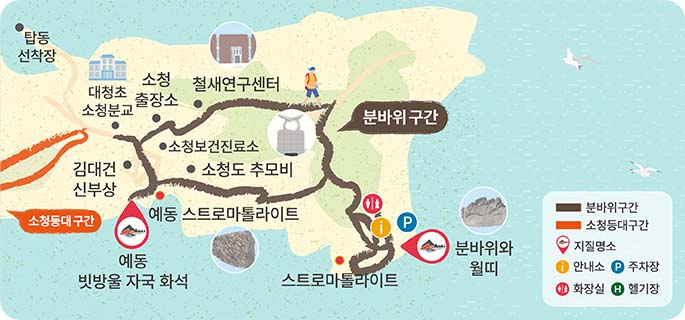
Bunbawi Rock Section (2.1km / 1hour)
- Geology+Ecology +Culture
• Exploration Highlights: Embark on a journey through geology, ecology,
and culture along a tidal path
that winds through
the white Bunbawi Rock, only visible at low tide.
: Ye-dong Village - Ye-dong Port - Bunbawi Rock Trail -
Bunbawi Rock -
Bunbawi Rock Tidal Path - Bunbawi
Rock Information Office
(Open only 2 hours before and
after low tide)

Socheong Lighthouse Section
(2.8km / 2 hours)
- Geology + Ecology + History
• Exploration Highlights: Embark on a comprehensive journey encompassing
geology, ecology, history,
and culture. Pass through
the villages of Socheongdo Island (Ye-dong and
Nohwa
-dong), visit a camellia colony, the statue of
Andrew Kim Taegon, a lighthouse,
and explore diabase
columnar joints in the cliffs beneath the lighthouse
: Ye-dong Village - Nohwa-dong Village -
Socheong lighthouse



 KOR
KOR ENG
ENG

